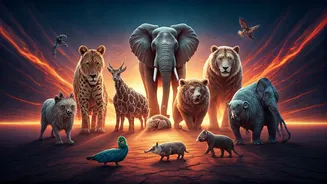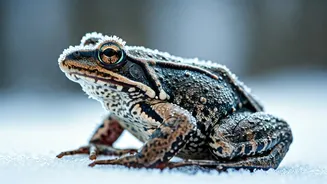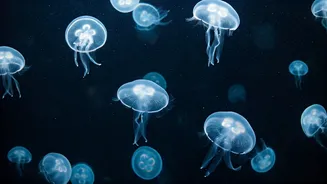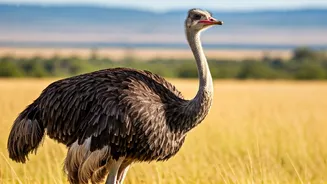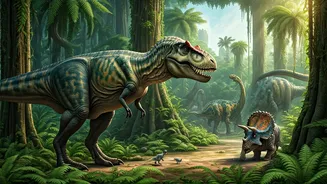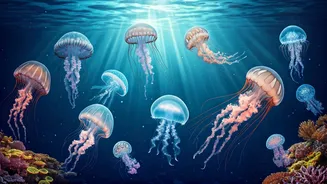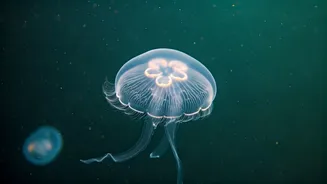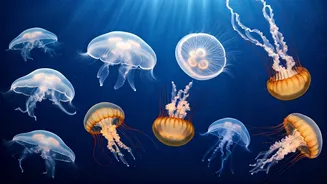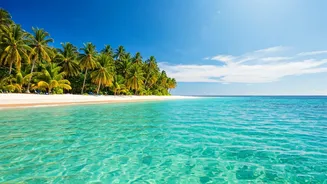The Wood Frog's Freeze
The Wood Frog showcases an incredible ability to survive freezing temperatures. Found across North America, these frogs can endure ice crystals forming
within their bodies. They achieve this remarkable feat by producing glucose in high concentrations, acting like a natural antifreeze that protects their cells. During the winter, their breathing and heartbeat cease, and they appear lifeless, but with the arrival of warmer weather, they thaw and return to normal, showcasing an extraordinary resilience. This survival strategy allows them to endure harsh winters and thrive in diverse habitats.
Tardigrades: Masters Survival
Tardigrades, often called water bears or moss piglets, are microscopic animals renowned for their ability to withstand extreme conditions. These creatures can survive in the vacuum of space, endure radiation, and withstand temperatures near absolute zero. They achieve this by entering a cryptobiotic state, where they retract their limbs, dry out, and essentially shut down their metabolic processes. This state, known as tun state, allows them to survive for decades until conditions improve, when they rehydrate and resume normal activity. Their durability has made them a subject of intense scientific interest, pushing the boundaries of what life can endure.
The Amazing Resurrection
The resurrection fern, which clings to tree branches, is a plant that exhibits an extraordinary ability to revive after apparent death. During dry periods, the fern's leaves curl up and turn brown, appearing lifeless. However, when moisture returns, the leaves unfurl, and the fern springs back to life, regaining its vibrant green color. This process involves the fern's cells effectively shutting down, preserving essential functions while dormant. It's a testament to nature's ability to adapt and survive environmental fluctuations, allowing the fern to endure harsh conditions.
The Artemia's Resilience
Artemia, also known as brine shrimp, are small crustaceans that demonstrate remarkable resilience, particularly in harsh environments. They produce dormant eggs, called cysts, that can withstand extreme conditions like high salinity, temperature fluctuations, and even dehydration. These cysts can survive for years, even decades, in a dry state. When conditions become favorable with the return of water, the cysts hatch, and the Artemia begin to develop, allowing them to rapidly colonize their surroundings. This survival strategy ensures the continuation of the species even in challenging environments.
The Desert's Annual Wonders
Desert pupfish are another example of a species that have adapted to live in extreme environments, showcasing their ability to revive. They can survive in isolated desert pools and endure drastic temperature swings. During dry periods, they may have periods of dormancy. If the water dries up completely, the eggs can survive until the next rainfall, allowing the fish to return. Their capacity to withstand these conditions and revive is a testament to evolution's ability to shape resilience.
The Winter Survival
The painted turtle, common throughout North America, exhibits fascinating survival mechanisms in winter. These turtles can withstand freezing conditions, primarily by undergoing a form of hibernation. They burrow in the mud at the bottom of ponds and lakes, where they absorb oxygen through their skin. They slow their metabolism dramatically, reducing their need for oxygen. This slow-down allows them to endure the harsh conditions of winter and revive when the weather warms, highlighting the adaptability of reptiles.
The Antarctic Marvel
Antarctic icefish, which reside in the frigid waters surrounding Antarctica, provide another case of exceptional adaptation. They lack hemoglobin, which transports oxygen in blood; instead, they survive by having dissolved oxygen in their blood. Their unique physiology allows them to flourish in extremely cold and oxygen-rich waters. While not exactly "reviving," they have adapted to survive in an environment that would be hostile to most other fish, exhibiting a high degree of cold tolerance. This adaptation enables them to remain active even when other species could not.
The Seed's Resuscitation
Plant seeds, in general, provide a remarkable example of suspended animation. Many seeds can lie dormant for extended periods, even years, until conditions are favorable for germination. They contain all the necessary components for life but in a state of suspended animation. With the availability of water, oxygen, and the right temperature, they revive, initiating growth. This natural revival process allows plants to persist and thrive, even in unpredictable environments. Seeds represent one of nature's greatest achievements in survival.
The African Lungfish
African lungfish display an extraordinary ability to survive prolonged dry periods. These fish can burrow into mud and encase themselves in a cocoon of mucus, reducing their metabolic rate. They can then survive for months, even years, in this state, relying on the mucus cocoon to maintain moisture. When the rains return and the water levels rise, they emerge, demonstrating a remarkable resilience. This capability exemplifies how evolution can help creatures to survive in unpredictable habitats.
The Naked Mole-Rat Secrets
Naked mole-rats, known for their unique appearance and social behavior, also exhibit surprising adaptations. These creatures can survive for extended periods without oxygen. In environments where oxygen levels are low, they can slow their metabolism and use fructose as a fuel source instead of glucose, unlike most mammals. While this adaptation isn't precisely "revival," it gives them an ability to cope with extremely challenging conditions. Their unusual biology provides key insights into the adaptability that enables their survival in underground environments.
